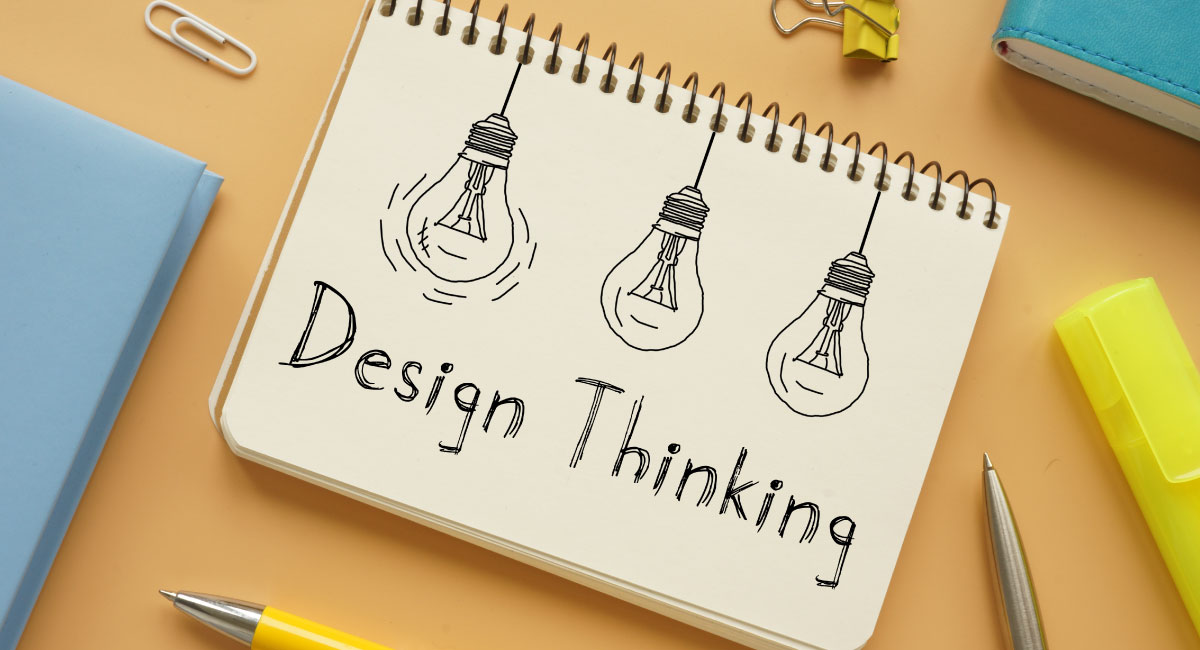We live in an increasingly complex world. As a result, this complicated world poses complex, unusual problems that require solutions that can’t be arrived at by conventional ways of thinking. Today’s designers are adopting design thinking more often to solve these problems, and that’s why we’re here today.
This article explores the design thinking process. We will define the term, explain its goals, phases, processes, and benefits, and explain how it contributes to the UX/UI design world. We also share an online UX/UI design program to help professionals gain the latest skills and experience to succeed in their careers.
What is Design Thinking?
Design thinking is a non-linear, iterative methodology that provides a solution-based approach to problem-solving. This methodology is advantageous when used to tackle complex, undefined problems because it strives to understand the human needs involved, reframing the problem in human-centric terms, creating many ideas during brainstorming sessions, and adopting a more hands-on approach to testing and prototyping.
Design thinking is a problem-solving approach that focuses more on innovation and creation. Cognitive scientist and Nobel Prize laureate Herbert A first mentioned this human-centric design methodology, Simon, in 1969, so the concept isn’t super-modern. It’s been around for a while.
In the business world, it deviates from the traditional problem-solving process, where people consider how to produce a valuable product for a company that could generate more profits. Design thinking puts the customer first, with the troubleshooting team trying to think about their problems and how to help them.
Also Read: How to Design a User-Friendly Interface?
Why Does Design Thinking Matter?
Here are a few reasons why the design thinking process is integral to today’s marketplace.
- It teaches people how to problem-solve and innovate. Most people are used to solving problems that readily present themselves rather than going out of their way to look for problems. Design thinking encourages people to solve problems creatively, pushing them to redefine the problem space and look for the challenge worth solving. This practice is especially useful in business when optimizing internal processes, designing a competitive digital product, or reinventing the whole business model.
- The process fosters teamwork and collaboration. The design thinking process brings together multidisciplinary teams, breaking down silos and encouraging people to collaborate while challenging their assumptions.
- The process offers a proven competitive advantage. Design-led companies consistently outperform their competitors. As mentioned before, the design thinking process is designed to develop solutions, products, and services that users want and ensure that these offerings are technologically feasible and economically viable from a business perspective. Its user-first approach, partnered with frequent and early testing, helps minimize risks, drive customer engagement, and ultimately boost the company’s bottom line.
The Goals of the Design Thinking Process
The whole point of the design thinking process is to design easy-to-use products instead of expecting customers to adapt to the products. That’s the main goal.
The secondary goal of design thinking is to find solutions for problems that were not initially considered. So, a team engaging in it is not only working on the obvious issues that a project presents but also thinking outside the box and considering issues that need to be more intuitively obvious.
In summary, the design thinking process goal is to develop solutions that are:
- Desirable to the user
- Viable for the business
- Technologically feasible
Now that we know more about the goals of the design thinking process, let’s take an in-depth look at its five steps or phases.
The Five Phases of the Design Thinking Process
The process is divided into five design thinking steps. However, it is nonlinear, meaning designers can iteratively revisit each phase. In other words, they can continuously reexamine the product and processes to better understand users, redefine problems, challenge assumptions, and create innovative solutions.
- Empathize. The first design thinking step is empathy. You must understand who your customers are and what they want or need to create desirable products and services. What are their expectations about the product? What challenges and obstacles do they face within that context? During this phase, you’ll observe and engage with real people, conduct interviews, note how they interact with an existing product, and pay attention to physical cues like facial expressions or body language. As the initial step in the design thinking process, the empathize phase encourages designers to set their assumptions aside and use first-hand insights to design something with real users in mind.
- Define. In the second stage, you will define the user problem that needs solving. First, gather the findings from the empathize phase and begin piecing them together. Ask yourself what common themes and patterns you observed and what user needs and challenges consistently emerged. After synthesizing the findings, formulate a problem statement. A problem statement, often called a point of view (POV) statement, outlines the issue or challenge to be addressed. Like everything else in the design thinking process, the problem statement constantly focuses on the user. Instead of framing your problem statement like a business goal (“We need to increase online orders among young adults by 33%”), you frame it from the user’s perspective (“Twentysomethings in rural areas are looking for ways to order products online with minimal clicks.”). By the conclusion of this phase, you will have a clear, coherent problem statement that sets the course for the rest of the design process.
- Ideate. The third stage generates ideas. By now, you know your target users, what they expect from your product or service, and a clear problem statement you’d like to solve. Now, it’s time to brainstorm possible solutions. The ideation phase is a judgment-free zone that encourages groups to wander away from the norm and explore new angles, thinking outside the box. Conduct ideation sessions to spitball as many ideas as possible without considering their feasibility. Expect to continuously refer to your problem statement throughout this stage of the design thinking process. As you get ready to move on to the next phase, you’ll narrow your sessions’ results down to a handful of ideas, which will later be turned into prototypes to be tested by real users.
- Prototype. In the fourth design thinking step, you turn your ideas from stage three into actual prototypes. A prototype is typically a scaled-down version of the product or feature, anything from a simple paper model to an interactive digital representation. This stage aims to turn your ideas into something tangible that real users can test. This stage is vital in maintaining a user-centric approach, letting you gather feedback before completing product development. This stage ensures that the final design resolves the customer’s issues and is pleasant to use.
- Test. Our last design thinking step in the process is dedicated to testing, where you set your prototypes in front of actual users and see how well they interact with them. During the testing phase, you’ll watch the target users or the sample representative group as they interact with the prototype. You will also collect feedback on how the users felt throughout the process. The testing phase quickly highlights any design flaws that need addressing. Based on the lessons learned through user testing, your team will return and make the necessary improvements.
Also Read: A Guide to Improving and Measuring User Experience
The Benefits of the Design Thinking Process
We already discussed why the design thinking process matters, but let’s explore some tangible, specific benefits.
- It’s easy to follow. You don’t need any specific skills to start design thinking. The only things you need to know about design thinking are the process’s structure and how to control everything.
- It inspires creativity. Creativity drives project and product development. However, it can be challenging. It reveals and collects creative solutions from the team, making it easy to get customer inspiration.
- It enables satisfying solutions. Design thinking puts the customer first, and the customers eventually verify any solutions. The design thinking process ensures the methods you use to satisfy the customers.
- It’s versatile. Design thinking is not limited to product development; it can also be used in other industries such as business, education, science, etc.
- It defines the problem better. The project may need help that can only be defined with access to customers’ feedback. Design thinking can give insight into customers’ thoughts and actions.
- It improves efficiency. Design thinking relies on customer requirements to ensure the success of the proposed solution. Teams don’t have to spend time and resources creating a genuine, fully functional product to test; they need just a prototype with interactive capabilities that the customers can check out. This process saves much time, as the prototype can be easily updated. The company can produce the actual products once the customers have confirmed the prototype’s value.
The Value of Design Thinking in UX/UI Design
The design thinking process is particularly important in user experience (UX) design. UX designers place themselves in the user’s shoes, seeing and interacting with the products from the customer’s perspective and becoming empathetic to customer desires and grievances. These designers also follow a series of hands-on steps, often employed interchangeably with phases and stages.
This way of thinking helps address user behavior and environmental changes that might take time to become apparent. The design thinking approach benefits both the users and the company’s bottom line, as designers continuously test, research, and improve products. As a result, incorporating design thinking allows the UX team to do better-quality research, prototyping, and usability testing to better address human needs in our digital age.
Do You Want to Learn More About UX/UI Design?
If you want a UX/UI design career, check out this intense 20-week UX/UI online bootcamp. The online course provides live online classes, capstone projects, a designer toolkit, and Dribble portfolio creation as you learn top design tools like Balsamiq, Figma, Invision, Mural, and Sketch.
Glassdoor.com reports that UX/UI designers earn an average annual salary of $88,246. So, if you’re looking to expand your skillset or shoot for a new career, look at this comprehensive UX/UI design bootcamp and get the necessary skills to create top-notch products for today’s fast-paced digital marketplace.
Also Read: UX/UI Designer Salary: What Can You Expect?
FAQ
Q: What is the design thinking process in UX?
A: UX designers put themselves in the customer’s position, seeing and interacting with the products from their perspective and becoming sensitive to customer desires and grievances. Thus, incorporating design thinking allows the UX team to perform better-quality research, prototyping, and usability testing to address customer needs better.
Q: What are the stages of design thinking?
A: The five stages of the design thinking process are:
- Empathize
- Define
- Ideate
- Prototype
- Test
Q: What is the primary goal of design thinking?
A: The primary goal of the design thinking process is to create easy-to-use products instead of expecting customers to adapt to them.
You might also like to read:
How to Become a UX/UI Designer: A Comprehensive Guide
UX/UI Designer Career Path: A Comprehensive Guide
All About UX/UI Design Principles
Accessibility in UX Design: A Definitive Guide
Career Prep: Linux Interview Questions for UX/UI Design Professionals






